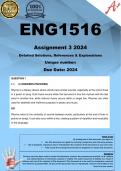ENG1516
Assignment 3 2024
Detailed Solutions, References & Explanations
Unique number:
Due Date: 2024
QUESTION 1
1.1. (2 ANSWERS PROVIDED)
Rhyme is a literary device where words have similar sounds, especially at the end of lines
in a poem or song. End rhyme occurs when the last word in one line rhymes with the last
word in another line, while internal rhyme occurs within a single line. Rhymes are often
used for aesthetic and rhythmic purposes in poetry and music.
OR
Rhyme refers to the similarity of sounds between words, particularly at the end of lines in
poems or songs. It can also occur within a line, creating a pattern of repetition and musicality
in the language.
Terms of use
By making use of this document you agree to:
• Use this document as a guide for learning, comparison and reference purpose,
• Not to duplicate, reproduce and/or misrepresent the contents of this document as your own work,
• Fully accept the consequences should you plagiarise or misuse this document.
Disclaimer
Extreme care has been used to create this document, however the contents are provided “as is” without
any representations or warranties, express or implied. The author assumes no liability as a result of
reliance and use of the contents of this document. This document is to be used for comparison, research
and reference purposes ONLY. No part of this document may be reproduced, resold or transmitted in any
form or by any means.
, +27 67 171 1739
QUESTION 1
1.1. (2 ANSWERS PROVIDED)
Rhyme is a literary device where words have similar sounds, especially at the end of
lines in a poem or song. End rhyme occurs when the last word in one line rhymes with
the last word in another line, while internal rhyme occurs within a single line. Rhymes
are often used for aesthetic and rhythmic purposes in poetry and music.
OR
Rhyme refers to the similarity of sounds between words, particularly at the end of lines
in poems or songs. It can also occur within a line, creating a pattern of repetition and
musicality in the language.
1.2. (2 ANSWERS PROVIDED)
End rhyme is when words at the end of separate lines in a poem or song rhyme with
each other, while internal rhyme is when words within the same line of a poem or song
rhyme with each other. So, end rhyme occurs at the end of lines, and internal rhyme
occurs within lines.
OR
End rhyme occurs when the vowel sounds in the words at the end of the lines in a
poem or song rhyme with each other. Internal rhyme, on the other hand, occurs when
rhyming words are found within the lines of a poem or song, not just at the end of the
lines. This adds a different layer of musicality and rhythm to the writing.
1.3. (2 ANSWERS PROVIDED)
Nursery rhymes and poetry are valuable tools for young learners to acquire basic
language and mathematical skills. The rhythmic and repetitive nature of nursery
rhymes helps children to develop their language skills by introducing them to different
sounds, words, and phonetic patterns. Through reciting and singing nursery rhymes,
children learn to pronounce and articulate words, improving their language
Disclaimer
Extreme care has been used to create this document, however the contents are provided “as is” without
any representations or warranties, express or implied. The author assumes no liability as a result of
reliance and use of the contents of this document. This document is to be used for comparison, research
and reference purposes ONLY. No part of this document may be reproduced, resold or transmitted in any
form or by any means.




